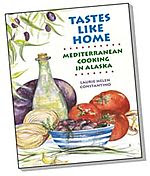 Assuming the weather holds, there are two more Saturday Farmers’ Markets this year in Anchorage: October 10 and October 17. Last week the tables were well-stocked with a wide array of vegetables; our purchases included lime-green Romanesco broccoli, yellow cauliflower, and a fresh-cut stalk of Brussels sprouts.
Assuming the weather holds, there are two more Saturday Farmers’ Markets this year in Anchorage: October 10 and October 17. Last week the tables were well-stocked with a wide array of vegetables; our purchases included lime-green Romanesco broccoli, yellow cauliflower, and a fresh-cut stalk of Brussels sprouts.
These vegetables, combined with a simple Mustard-Caper Butter, are absolutely delicious on their own, or served with grilled meat, poultry, or sausages. I rarely cook with butter, but do so here because it just tastes so damn good. Quick - head to your nearest farmers’ market for the ingredients!
Romanesco Broccoli, Cauliflower, and Brussels Sprouts with Mustard-Caper Butter
Serves 6-8Adapted from Local Flavors, Deborah Madison (New York 2002)
Roasting the vegetables concentrates and sweetens their flavor. However, you can simplify the dish even further by steaming the vegetables instead. Whether you steam or roast, make sure not to overcook the vegetables; they are best when they retain a little crunch. If you don't have access to beautiful Romanesco broccoli, regular broccoli can be substituted.
Mustard Caper Butter:
2 garlic cloves
1/4-1/2 tsp. salt
3 Tbsp. chopped thyme
1/4 cup drained small capers, rinsed
1 Tbsp. finely grated lemon peel
Freshly ground black pepper
6 Tbsp. butter, softened
1 Tbsp. Dijon mustard
Vegetables:
1 stalk (or 1 pound) Brussels sprouts
1 small head Romanesco or regular broccoli
1 small head white cauliflower
2 Tbsp. olive oil
Salt
Freshly ground black pepper
Preheat the oven to 450°F.
Make the Mustard-Caper Butter: Pound the garlic with 1/4 tsp. salt in a mortar until smooth. Pound the thyme, capers, lemon peel, and freshly ground black pepper into the garlic. Pound in the butter and mustard, making sure the other ingredients are evenly distributed in the butter. You can also mix the butter in a food processor. If you do, add the capers only after the other ingredients are thoroughly combined and pulse in the capers so they stay a little chunky. (The butter can be made ahead, refrigerated, and brought to room temperature before serving.)
Cook the Vegetables: Snap the Brussels sprouts off the stalk, trim off their tough base, and slice them in half. Bring a large pot of salted water to a boil. Add the Brussels sprouts and cook for 3 minutes. Drain and rinse with very cold water. Cut the cauliflower and Romanesco broccoli into florets. Put the vegetables, including the drained Brussels sprouts, on a rimmed baking sheet and toss with olive oil and a light sprinkling of salt and freshly ground black pepper. Bake for 10 minutes.
Finish the Dish: Put the roasted vegetables in a bowl and toss with the Mustard-Caper Butter until it melts and coats the vegetables. Taste and add salt or freshly ground black pepper, as needed.
~~~~~~~~~~~~~~~~~~~~~~~~~~~~~~~~~~~~
 Weekend Herb Blogging celebrates the flavors and textures of herbs, fruits, and vegetables. Each week a different blogger takes responsibility for summarizing the delicious and nutritious recipes posted to Weekend Herb Blogging in the preceding week. This week it’s my turn.
Weekend Herb Blogging celebrates the flavors and textures of herbs, fruits, and vegetables. Each week a different blogger takes responsibility for summarizing the delicious and nutritious recipes posted to Weekend Herb Blogging in the preceding week. This week it’s my turn.
























 Assuming the weather holds, there are two more Saturday Farmers’ Markets this year in Anchorage: October 10 and October 17. Last week the tables were well-stocked with a wide array of vegetables; our purchases included lime-green
Assuming the weather holds, there are two more Saturday Farmers’ Markets this year in Anchorage: October 10 and October 17. Last week the tables were well-stocked with a wide array of vegetables; our purchases included lime-green 


